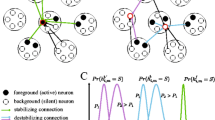Abstract
We developed a cooperative model of the cortical column incorporating an idealized subunit, the trion (which represents a localized group of neurons), and a discrete time step for firing. We found that networks composed of a small number of trions (with symmetric interactions) supported up to thousands of quasi-stable, periodic firing patterns (MPs) which could be selected out with only small changes in interaction strengths using a Hebb-type algorithm. Here we report a study of the associative recall properties showing striking features: By considering all possible initial firing patterns (for a given set of network connections), we find 1) It takes on the average only 2–5 time steps to recall an MP. 2) Many of the MPs can be individually accessed by thousands of different initial patterns. The variety of examples presented illustrate the rich, general nature of the model.
Similar content being viewed by others
References
Amari S, Arbib MA (eds) (1982) Competition and cooperation in neural nets. Springer, Berlin Heidelberg New York
Edelman GM (1978) Group selection and phasic reentrant signaling: a theory of higher brain function. In: Edelman GM, Mountcastle VB (eds) The mindful brain. MIT, Cambridge, pp 51–100
Fisher ME, Selke W (1980) Infinitely many commensurate phases in a simple Ising model. Phys Rev Lett 44:1502–1505
Fisher ME, Selke W (1981) Low temperature analysis of the axial next-nearest neighbour Ising model near its multiphase point. Philos Trans R Soc Lond Ser A302:1–44
Gilbert CD, Wiesel TN (1983) Clustered intrinsic connections in cat visual cortex. J Neurosci 3:1116–1133
Hebb DO (1949) The organization of behavior. Wiley, New York
Hinton GE, Anderson JA (eds) (1981) Parallel models of associative memory. Lawrence Erlbaum, Hillsdale
Hopfield JJ (1982) Neural networks and physical systems with emergent collective computational abilities. Proc Natl Acad Sci USA 79:2554–2558
Kohonen T, Oja E, Lehtiö P (1981) Storage and processing of information in distributed associative memory systems. In: Hinton GE, Anderson JA (eds) Parallel models of associative memory. Lawrence Erlbaum. Hillsdale, pp 105–143
Little WA, Shaw GL (1975) A statistical theory of short and long term memory. Behav Biol 14:115–133
Little WA, Shaw GL (1978) Analytic study of the storage capacity of a neural network. Math Biosci 39:281–290
MacGregon RJ, Lewis ER (1977) Neural modeling. Plenum Press, New York
Morrell F (1967) Electrical signs of sensory coding. In: Quarton GC, Melnechuk T, Schmitt FO (eds) The neurosciences: a study program. Rockefeller University, New York, pp 452–469
Morrell F, Hoeppner TJ, de Toledo-Morrell L (1983) Exp Neurol 80:111–146
Mountcastle VB (1978) An organizing principle for cerebral function: the unit module and the distributed system. In: Edelman GM, Mountcastle VB (eds) The mindful brain. MIT, Cambridge, pp 1–50
Pearson JC (1985) Information processing within cortical columns: the role of interacting assemblies. Ph D Thesis, University of California, Irvine
Prisco GVD (1984) Hebb synaptic plasticity. Prog Neurobiol 22:89–102
Roney KJ, Shaw GL (1980) Analytic study of assemblies of neurons in memory storage. Math Biosci 51:25–41
Shaw GL (1978) Space-time correlations of neuronal firing related to memory storage capacity. Brain Res Bull 3:107–113
Shaw GL, Harth E, Scheibel AB (1982) Cooperativity in brain function: assemblics of approximately 30 neurons. Exp Neurol 77:324–358
Shaw GL, Rinaldi PC, Pearson JC (1983) Processing capability of the primary visual cortex and possible physiological basis for an apparent motion illusion. Exp Neurol 79:293–298
Shaw GL, Silverman DJ, Pearson JC (1985) Model of cortical organization embodying a basis for a theory of information processing and memory recall. Proc Natl Acad Sci USA 82:2364–2368
Wolfram S (1983) Statistical mechanics of cellular automata. Rev Mod Phys 55:601–644
Yates F (ed) (1984) Proceedings of conference on chemically based computer design. University of California, Los Angeles
Author information
Authors and Affiliations
Rights and permissions
About this article
Cite this article
Silverman, D.J., Shaw, G.L. & Pearson, J.C. Associative recall properties of the trion model of cortical organization. Biol. Cybern. 53, 259–271 (1986). https://doi.org/10.1007/BF00336996
Received:
Issue Date:
DOI: https://doi.org/10.1007/BF00336996




